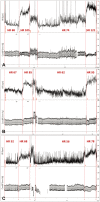Effect of Food Intake on Hemodynamic Parameters during the Tilt-Table Test in Patients with Postural Orthostatic Tachycardia Syndrome
- PMID: 30877690
- PMCID: PMC6444156
- DOI: 10.3988/jcn.2019.15.2.205
Effect of Food Intake on Hemodynamic Parameters during the Tilt-Table Test in Patients with Postural Orthostatic Tachycardia Syndrome
Abstract
Background and purpose: The aim of this study was to determine the effect of food intake on the heart rate (HR) in postural orthostatic tachycardia syndrome (POTS).
Methods: The following five-phase protocol was applied to 41 subjects who had a sustained HR increment of ≥30 beats/min within 10 min of standing in an initial tilt-table test: 1) 10-min supine phase, 2) 10-min 70°-tilted phase, 3) ingestion of 400 mL of Nutridrink Multi Fibre®, 4) 45-min supine phase, and 5) 10-min 70°-tilted phase. Subjects were divided into four groups: A) difference in HR for standing vs. supine (ΔHR) before the meal of ≥30 beats/min (n=13), B) ΔHR <30 beats/min before the meal but ≥30 beats/min after the meal (n=12), and C) ΔHR <30 beats/min both before and after the meal (n=16). Group D consisted of 10 healthy subjects.
Results: Before the meal, ΔHR was significantly higher in group A than in all of the other groups, and in group B than in group D (p<0.001). After the meal, ΔHR was significantly higher in groups A and B (p<0.001 and p<0.0001, respectively). When we pooled patients (according to their symptoms) from group A and B into a POTS group and from group C and D into a non-POTS group, an increase in HR of 25 beats/min before the meal had a sensitivity of 92.0% and a specificity of 80.8%. After the meal, an increase in HR of 30 beats/min had a sensitivity of 96.0% and a specificity of 96.2%.
Conclusions: Food intake can significantly alter the results of the tilt-table test and so should be taken into account when diagnosing POTS.
Keywords: food intake; postural orthostatic tachycardia syndrome; tilt-table test.
Copyright © 2019 Korean Neurological Association.
Conflict of interest statement
The authors have no financial conflicts of interest.
Figures




Similar articles
-
Heart rate and heart rate variability comparison between postural orthostatic tachycardia syndrome versus healthy participants; a systematic review and meta-analysis.BMC Cardiovasc Disord. 2019 Dec 30;19(1):320. doi: 10.1186/s12872-019-01298-y. BMC Cardiovasc Disord. 2019. PMID: 31888497 Free PMC article.
-
Can standing replace upright tilt table testing in the diagnosis of postural tachycardia syndrome (POTS) in the young?Clin Auton Res. 2025 Apr;35(2):257-266. doi: 10.1007/s10286-024-01080-x. Epub 2024 Nov 26. Clin Auton Res. 2025. PMID: 39592549
-
Diagnosing postural tachycardia syndrome: comparison of tilt testing compared with standing haemodynamics.Clin Sci (Lond). 2013 Jan;124(2):109-14. doi: 10.1042/CS20120276. Clin Sci (Lond). 2013. PMID: 22931296 Free PMC article.
-
[Changes of plasma intermedin during head-up tilt test in children with postural tachycardia syndrome and its significance].Zhonghua Er Ke Za Zhi. 2015 May;53(5):375-8. Zhonghua Er Ke Za Zhi. 2015. PMID: 26080669 Chinese.
-
[Postural orthostatic tachycardia syndrome (POTS)--pathophysiology, diagnostics, and treatment].Przegl Lek. 2014;71(8):450-3. Przegl Lek. 2014. PMID: 25546918 Review. Polish.
Cited by
-
Worsening Postural Tachycardia Syndrome Is Associated With Increased Glucose-Dependent Insulinotropic Polypeptide Secretion.Hypertension. 2022 May;79(5):e89-e99. doi: 10.1161/HYPERTENSIONAHA.121.17852. Epub 2022 Mar 2. Hypertension. 2022. PMID: 35232225 Free PMC article.
-
Heart rate and heart rate variability comparison between postural orthostatic tachycardia syndrome versus healthy participants; a systematic review and meta-analysis.BMC Cardiovasc Disord. 2019 Dec 30;19(1):320. doi: 10.1186/s12872-019-01298-y. BMC Cardiovasc Disord. 2019. PMID: 31888497 Free PMC article.
-
Frontal lobe hemodynamics detected by functional near-infrared spectroscopy during head-up tilt table tests in patients with electrical burns.Front Hum Neurosci. 2022 Sep 8;16:986230. doi: 10.3389/fnhum.2022.986230. eCollection 2022. Front Hum Neurosci. 2022. PMID: 36158619 Free PMC article.
-
Do meals affect heart rate and symptoms in postural orthostatic tachycardia syndrome?Clin Auton Res. 2022 Feb;32(1):65-67. doi: 10.1007/s10286-021-00835-0. Epub 2021 Nov 18. Clin Auton Res. 2022. PMID: 34792683 Free PMC article. No abstract available.
References
-
- Robertson D. The epidemic of orthostatic tachycardia and orthostatic intolerance. Am J Med Sci. 1999;317:75–77. - PubMed
-
- Adamec I, Lovrić M, Žaper D, Barušić AK, Bach I, Junaković A, et al. Postural orthostatic tachycardia syndrome associated with multiple sclerosis. Auton Neurosci. 2013;173:65–68. - PubMed
LinkOut - more resources
Full Text Sources

